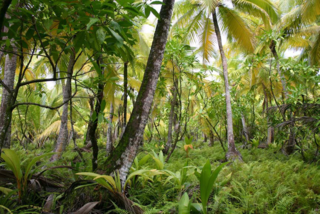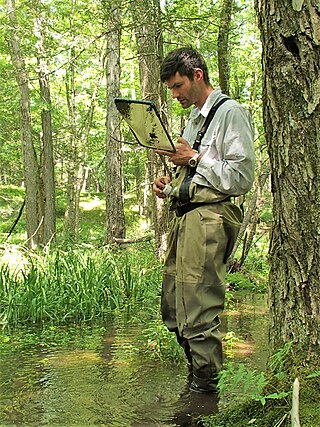Related Research Articles

In ecology, a niche is the match of a species to a specific environmental condition. It describes how an organism or population responds to the distribution of resources and competitors and how it in turn alters those same factors. "The type and number of variables comprising the dimensions of an environmental niche vary from one species to another [and] the relative importance of particular environmental variables for a species may vary according to the geographic and biotic contexts".

An invasive species is an introduced species that harms its new environment. Invasive species adversely affect habitats and bioregions, causing ecological, environmental, and/or economic damage. The term can also be used for native species that become harmful to their native environment after human alterations to its food web. Since the 20th century, invasive species have become serious economic, social, and environmental threats worldwide.
An ecological or environmental crisis occurs when changes to the environment of a species or population destabilizes its continued survival. Some of the important causes include:

Habitat fragmentation describes the emergence of discontinuities (fragmentation) in an organism's preferred environment (habitat), causing population fragmentation and ecosystem decay. Causes of habitat fragmentation include geological processes that slowly alter the layout of the physical environment, and human activity such as land conversion, which can alter the environment much faster and causes the extinction of many species. More specifically, habitat fragmentation is a process by which large and contiguous habitats get divided into smaller, isolated patches of habitats.
Realized niche width is a phrase relating to ecology, is defined by the actual space that an organism inhabits and the resources it can access as a result of limiting pressures from other species. An organism's ecological niche is determined by the biotic and abiotic factors that make up that specific ecosystem that allow that specific organism to survive there. The width of an organism's niche is set by the range of conditions a species is able to survive in that specific environment.

Ecological restoration, or ecosystem restoration, is the process of assisting the recovery of an ecosystem that has been degraded, damaged, or destroyed. It is distinct from conservation in that it attempts to retroactively repair already damaged ecosystems rather than take preventative measures. Ecological restoration can reverse biodiversity loss, combat climate change, and support local economies.

In ecology, a disturbance is a temporary change in environmental conditions that causes a pronounced change in an ecosystem. Disturbances often act quickly and with great effect, to alter the physical structure or arrangement of biotic and abiotic elements. A disturbance can also occur over a long period of time and can impact the biodiversity within an ecosystem.

There is an ongoing decline in plant biodiversity, just like there is ongoing biodiversity loss for many other life forms. One of the causes for this decline is climate change. Environmental conditions play a key role in defining the function and geographic distributions of plants. Therefore, when environmental conditions change, this can result in changes to biodiversity. The effects of climate change on plant biodiversity can be predicted by using various models, for example bioclimatic models.

Ecological dominance is the degree to which one or several species have a major influence controlling the other species in their ecological community or make up more of the biomass. Both the composition and abundance of species within an ecosystem can be affected by the dominant species present.

Plant ecology is a subdiscipline of ecology that studies the distribution and abundance of plants, the effects of environmental factors upon the abundance of plants, and the interactions among plants and between plants and other organisms. Examples of these are the distribution of temperate deciduous forests in North America, the effects of drought or flooding upon plant survival, and competition among desert plants for water, or effects of herds of grazing animals upon the composition of grasslands.
In ecology, a priority effect refers to the impact that a particular species can have on community development as a result of its prior arrival at a site. There are two basic types of priority effects: inhibitory and facilitative. An inhibitory priority effect occurs when a species that arrives first at a site negatively affects a species that arrives later by reducing the availability of space or resources. In contrast, a facilitative priority effect occurs when a species that arrives first at a site alters abiotic or biotic conditions in ways that positively affect a species that arrives later. Inhibitory priority effects have been documented more frequently than facilitative priority effects. Studies indicate that both abiotic and biotic factors can affect the strength of priority effects.. Priority effects are a central and pervasive element of ecological community development that have significant implications for natural systems and ecological restoration efforts.
Flowering synchrony is the amount of overlap between flowering periods of plants in their mating season compared to what would be expected to occur randomly under given environmental conditions. A population which is flowering synchronously has more plants flowering at the same time than would be expected to occur randomly. A population which is flowering asynchronously has fewer plants flowering at the same time than would be expected randomly. Flowering synchrony can describe synchrony of flowering periods within a year, across years, and across species in a community. There are fitness benefits and disadvantages to synchronized flowering, and it is a widespread phenomenon across pollination syndromes.

Mark C. Urban is a biologist and associate professor in ecology and evolutionary biology at the University of Connecticut. His work focuses on the ecological and evolutionary mechanisms that shape natural communities across multiple spatial scales.
Disease ecology is a sub-discipline of ecology concerned with the mechanisms, patterns, and effects of host-pathogen interactions, particularly those of infectious diseases. For example, it examines how parasites spread through and influence wildlife populations and communities. By studying the flow of diseases within the natural environment, scientists seek to better understand how changes within our environment can shape how pathogens, and other diseases, travel. Therefore, diseases ecology seeks to understand the links between ecological interactions and disease evolution. New emerging and re-emerging infectious diseases are increasing at unprecedented rates which can have lasting impacts on public health, ecosystem health, and biodiversity.
Elizabeth T. Borer is an American ecologist and a professor of ecology in the College of Biological Sciences at the University of Minnesota.
The enemy release hypothesis is among the most widely proposed explanations for the dominance of exotic invasive species. In its native range, a species has co-evolved with pathogens, parasites and predators that limit its population. When it arrives in a new territory, it leaves these old enemies behind, while those in its introduced range are less effective at constraining the introduced species' population. The result is sometimes rampant growth that threatens native species and ecosystems.
Herbivores' effects on plant diversity vary across environmental changes. Herbivores could increase plant diversity or decrease plant diversity. Loss of plant diversity due to climate change can also affect herbivore and plant community relationships Herbivores are crucial in determining the distribution, abundance, and diversity of plant populations. Research indicates that by consuming large amounts of plant biomass, herbivores can directly reduce the local abundance of plants, thereby affecting the spatial distribution of different plant species. For example, the impact of herbivory is typically more pronounced in grassland species than in woodland forbs, especially in environments that undergo frequent disturbances.
Jessica Gurevitch is a plant ecologist known for meta-analysis in the fields of ecology and evolution.
Julie L. Lockwood is an American ecologist who is a professor in the Department of Ecology, Evolution, and Natural Resources at Rutgers University. She is the Director of the Institute of Earth, Ocean, and Atmospheric Sciences. Her research investigates how invasive species impact natural ecosystems. In 2022, she was elected a Fellow of the American Association for the Advancement of Science.
Carol Anne Blanchette is research biologist at the University of California, Santa Barbara who is known for her work on marine intertidal zones and the biomechanics of marine organisms.
References
- 1 2 3 4 5 "Zarnetske CV" (PDF).
- ↑ "EEB Core Faculty". EEB Program at MSU.
- ↑ "Climate Change and the Past, Present, and Future of Biotic Interactions". ResearchGate. Retrieved 2019-02-11.
- ↑ Zarnetske, Phoebe Lehmann (2011). The influence of biophysical feedbacks and species interactions on grass invasions and coastal dune morphology in the Pacific Northwest, USA. Corvallis, Or.: Oregon State University. hdl:1957/23483. OCLC 754117116.
- ↑ "Member Profile". www.igert.org. Retrieved 2021-07-25.
- ↑ Co, Alex (February 19, 2013). "Multiplying Toward Extinction: The Effects of Climate Change on Species – Yale Scientific Magazine". www.yalescientific.org. Retrieved 2021-07-25.
- ↑ Zarnetske, Phoebe L.; Hacker, Sally D.; Seabloom, Eric W.; Ruggiero, Peter; Killian, Jason R.; Maddux, Timothy B.; Cox, Daniel (2012). "Biophysical feedback mediates effects of invasive grasses on coastal dune shape". Ecology. 93 (6): 1439–1450. doi:10.1890/11-1112.1. ISSN 1939-9170. PMID 22834384.
- ↑ Blois, J. L.; Zarnetske, P. L.; Fitzpatrick, M. C.; Finnegan, S. (2 August 2013). "Climate Change and the Past, Present, and Future of Biotic Interactions". Science. 341 (6145): 499–504. Bibcode:2013Sci...341..499B. doi:10.1126/science.1237184. PMID 23908227. S2CID 5819828.
- ↑ Zarnetske, Phoebe L.; Skelly, David K.; Urban, Mark C. (2012-06-22). "Biotic Multipliers of Climate Change". Science. 336 (6088): 1516–1518. Bibcode:2012Sci...336.1516Z. doi:10.1126/science.1222732. ISSN 0036-8075. PMID 22723403. S2CID 44173657.
- ↑ Zarnetske, Phoebe L.; Seabloom, Eric W.; Hacker, Sally D. (2010). "Non-target effects of invasive species management: beachgrass, birds, and bulldozers in coastal dunes". Ecosphere. 1 (5): art13. doi: 10.1890/ES10-00101.1 . ISSN 2150-8925.
- ↑ Zarnetske, Phoebe L.; Gouhier, Tarik C.; Hacker, Sally D.; Seabloom, Eric W.; Bokil, Vrushali A. (2013). "Indirect effects and facilitation among native and non-native species promote invasion success along an environmental stress gradient". Journal of Ecology. 101 (4): 905–915. doi: 10.1111/1365-2745.12093 . ISSN 1365-2745. S2CID 53480164.
- ↑ Zarnetske, Phoebe L.; Gurevitch, Jessica; Franklin, Janet; Groffman, Peter M.; Harrison, Cheryl S.; Hellmann, Jessica J.; Hoffman, Forrest M.; Kothari, Shan; Robock, Alan; Tilmes, Simone; Visioni, Daniele (2021-04-13). "Potential ecological impacts of climate intervention by reflecting sunlight to cool Earth". Proceedings of the National Academy of Sciences. 118 (15): e1921854118. Bibcode:2021PNAS..11821854Z. doi: 10.1073/pnas.1921854118 . ISSN 0027-8424. PMC 8053992 . PMID 33876741.
- ↑ Center, The Graduate; CUNY (2021-04-20). "High-Tech Climate Intervention: A Sun Reflector to Cool Earth?". SciTechDaily. Retrieved 2021-07-25.
- ↑ "Dr. Phoebe Zarnetske's paper highly commended for Harper Prize awarded by Journal of Ecology". College of Agriculture & Natural Resources. March 21, 2014. Retrieved 2021-07-25.
- ↑ Zarnetske, Phoebe L.; Gouhier, Tarik C.; Hacker, Sally D.; Seabloom, Eric W.; Bokil, Vrushali A. (2013). "Indirect effects and facilitation among native and non-native species promote invasion success along an environmental stress gradient". Journal of Ecology. 101 (4): 905–915. doi: 10.1111/1365-2745.12093 . ISSN 1365-2745. S2CID 53480164.
- ↑ University, Utah State (2006-03-16). "Natural Resources Researchers Excel at Recent Professional Meetings". Utah State Today. Retrieved 2021-07-25.
- ↑ "E. Lucy Braun Award, Phoebe L. Zarnetske, Utah State University" (PDF). 2005.